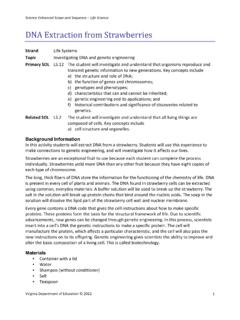Transcription of Viral Diseases of Strawberries - University of Florida
1 PP273 Viral Diseases of Strawberries1 Catalina Moyer, Vance M. Whitaker, and Natalia A. Peres21. This document is PP273, one of a series of the Plant Pathology Department, Florida Cooperative Extension Service, Institute of Food and Agricultural Sciences, University of Florida . Original publication date April 2010. Visit the EDIS Web Site at Catalina Moyer, senior biological scientist; Vance M. Whitaker, assistant professor of horticulture; Natalia A. Peres, assistant professor of plant pathology, University of Florida Gulf Coast Research and Education CenterThe Institute of Food and Agricultural Sciences (IFAS) is an Equal Opportunity Institution authorized to provide research, educational information and other services only to individuals and institutions that function with non-discrimination with respect to race, creed, color, religion, age, disability, sex, sexual orientation, marital status, national origin, political opinions or affiliations.
2 Department of Agriculture, Cooperative Extension Service, University of Florida , IFAS, Florida A. & M. University Cooperative Extension Program, and Boards of County Commissioners Cooperating. Millie Ferrer-Chancy, Interim DeanViral Diseases have not been an issue for Strawberries grown in Florida , probably because most viruses are symptomless on commercial cultivars. However, at the end of the 2008 2009 strawberry season, serological tests confirmed the presence of strawberry necrotic shock virus (SNSV) (formerly tobacco streak virus [TSV]) in research fields at the University of Florida Gulf Coast Research and Education Center (UF GCREC) and some commercial strawberry farms.
3 This publication provides basic information on Viral Diseases of Strawberries with particular emphasis on the presence of SNSV on Florida strawberry plants. Viruses in plantsBiologyViruses are smaller than bacteria or fungi and are not visible by light microscopy. They are submicroscopic parasites whose bodies have a variety of sizes and shapes (spherical, rod-shaped, isometric, etc.), which consist of DNA or RNA and protective proteins. Some viruses are among the most significant plant pathogens, as they reduce plant vigor, yield, and market value, or can even cause plant death. Viruses multiply by inducing the host cells to produce more virus particles.
4 Plant viruses are obligate parasites that cannot be grown in artificial media and require a host plant for their survival and multiplication. Virus symptoms may include: Necrotic local lesions: Dead or discolored and localized spots on plant tissueMottle: Uneven areas of light and dark yellowing (Fig. 1)Ringspot: Circular chlorotic spotsMosaic: Mixed areas of mottled and normal tissueChlorosis or yellowing: Pale or yellow areasMalformation, leaf distortion, and stunting: Irregular growth, dwarfing, and loss of vigorDetection, dissemination and controlVirus-infected plants may be symptomless, or the symptoms may be confused with those caused by bacteria, viroids, insect feeding, herbicide damage, nutritional deficiencies, high temperatures (Fig.)
5 2), Archival copy: for current recommendations see or your local extension Diseases of Strawberries2 Figure 1. Leaf of Fragaria vesca with mottle symptoms. (Photo: David Moore, UF/IFAS GCREC)air pollutants, or genetic abnormalities (Converse 1987). Figure 2. Symptoms caused by exposure to high temperatures in F. vesca. (Photo: Catalina Moyer, UF/IFAS GCREC)Detection and diagnosis of Viral infections can be achieved by biological assays, such as graft or sap inoculation of species or cultivars that are especially sensitive and show obvious symptoms (Martin 2004). If symptoms develop on these indicator plants, then the plant in question is positive for the virus (Fig.
6 3). This technique can detect many viruses, although it will not necessarily diagnose a specific 3. Fragaria virginiana plants: right, healthy; left, leaf distortion and stunting symptoms after grafting with virus-infected tissue. (Photo: Catalina Moyer, UF/IFAS GCREC)Enzyme-linked immunosorbent assay (ELISA) is a serological test that detects the presence of a specific antigen in plant tissue. Leaf sap from virus-infected plants (containing the antigen) is mixed with the antibody for the specific virus on a microplate. If the antigens and antibody match, a color develops, indicating the presence of the virus in the sample (Fig.
7 4). The wells in the microplate can be read visually as positive or negative or quantified with a colorimeter. Figure 4. ELISA microplate showing colorimetric reaction of virus-infected samples. (Photo: Catalina Moyer, UF/IFAS GCREC)Nucleic acid analysis is another technique to confirm Viral infection. Small amounts of DNA or RNA are amplified many times using polymerase chain reaction (PCR) and then detected with agarose gel electrophoresis. Nucleic acid analyses are very useful in detecting organisms that cannot be cultured or that are present in very small copy: for current recommendations see or your local extension Diseases of Strawberries3 Plant viruses are disseminated through seed or pollen, vegetative propagation, vectors (aphids, thrips, mites, whiteflies, leafhoppers, plant hoppers, beetles, and nematodes), and/or mechanically (Converse 1987).
8 Control of plant viruses is often difficult because viruses move readily between plants without detection and because there are no "viricides" or cures for virus-infected plants. Depending on the disease , proper management may include: chemical or biological control of vectors, use of resistant cultivars, use of clean propagation material ( , plant material cleaned by meristem culture and heat treatment), and exclusion (plant quarantine).Viruses in strawberriesIdentification of viruses in Strawberries began in the 1930s. Currently, more than 30 viruses are reported to infect Strawberries worldwide (Table 1) (Converse 1987; Martin and Tzanetakis 2006).
9 Viral infections of commercially grown Strawberries have the potential for economic impact, but growers usually do not observe problems because most viruses are eliminated during the early stages of propagation. New cultivars go through a clean propagation program where meristem culture, heat treatment, and disease testing are conducted before plants are delivered to registered nurseries for mass propagation. Therefore, strawberry nurseries start with clean plants; consequently, viruses are not easily spread into fruiting fields. Unfortunately, fruiting fields may become infected with viruses that have hosts other than Strawberries , such as bean, clover, tomato, and weed species, among others (Cupertino et al.)
10 1984; Klose et al. 1996).Heat treatment and meristem culture are frequently combined for virus elimination in Strawberries (Biswas, Hossain, and Islam 2007; Mullin et al. 1974). Well-rooted plants and daughter plants (stolons) are grown at 37 C for four to six weeks, followed by meristem removal and culture in vitro (Converse 1987). Heat treatment can also be applied to in vitro plantlets. After heat treatment and meristem culture, plants need to be tested again since some viruses may survive these main viruses affecting Strawberries include strawberry veinbanding virus (SVBV), strawberry crinkle virus (SCV) (Fig. 5), strawberry mottle virus (SMoV), and strawberry mild yellow edge (SMYEV).



















